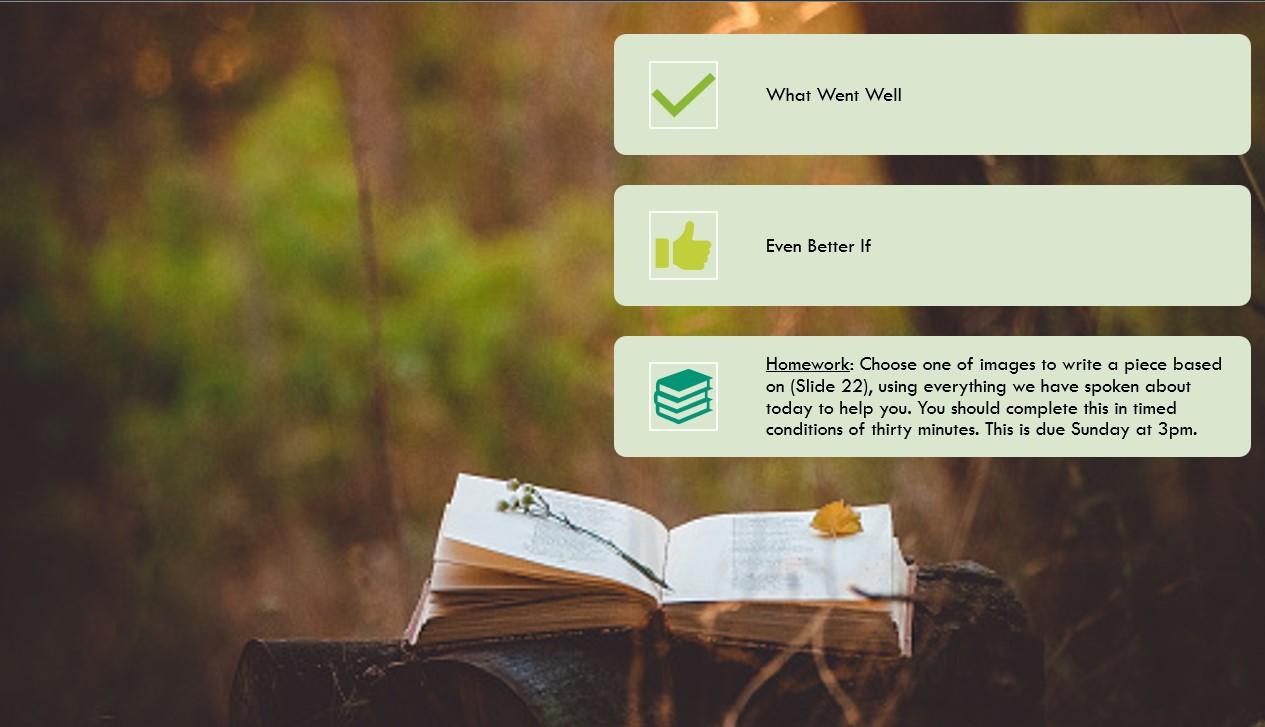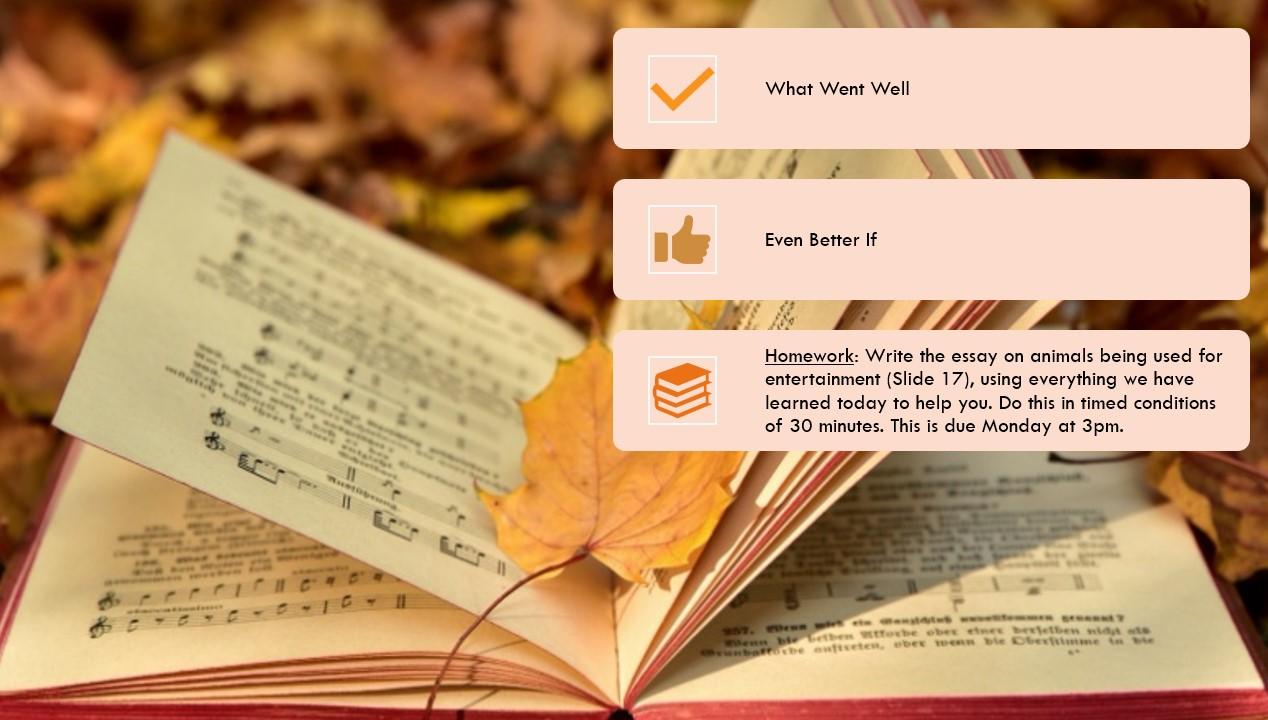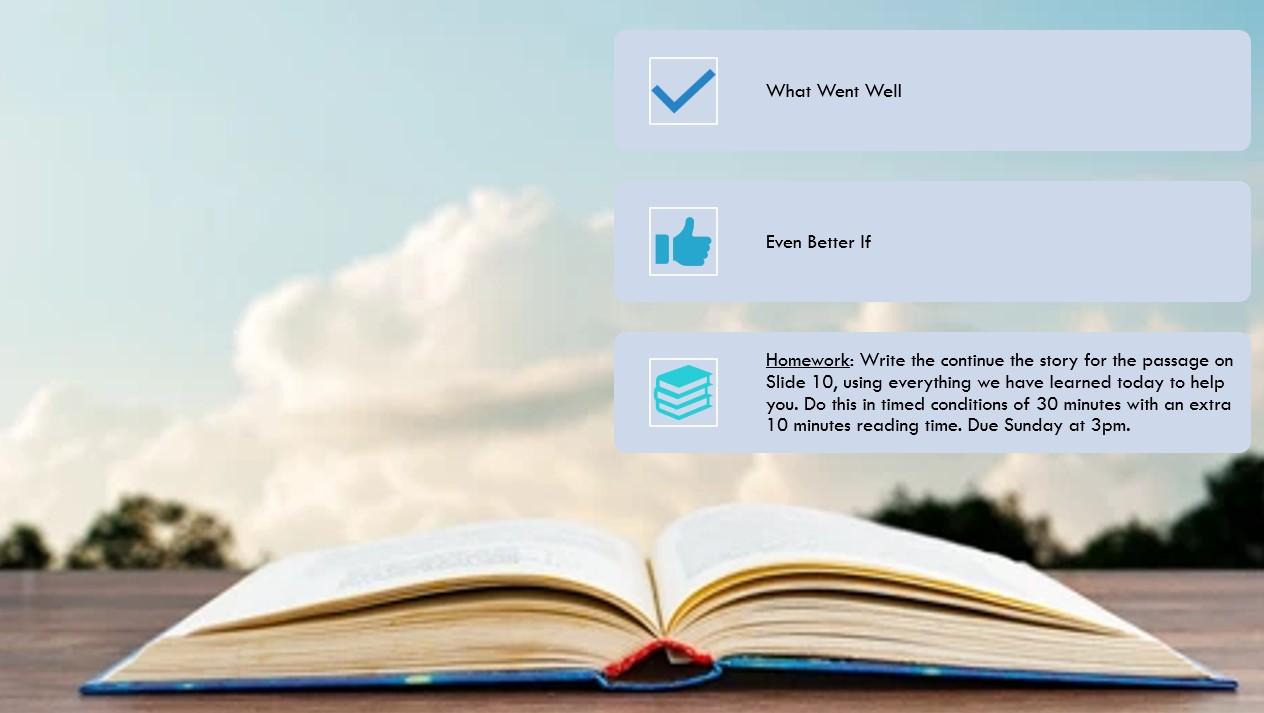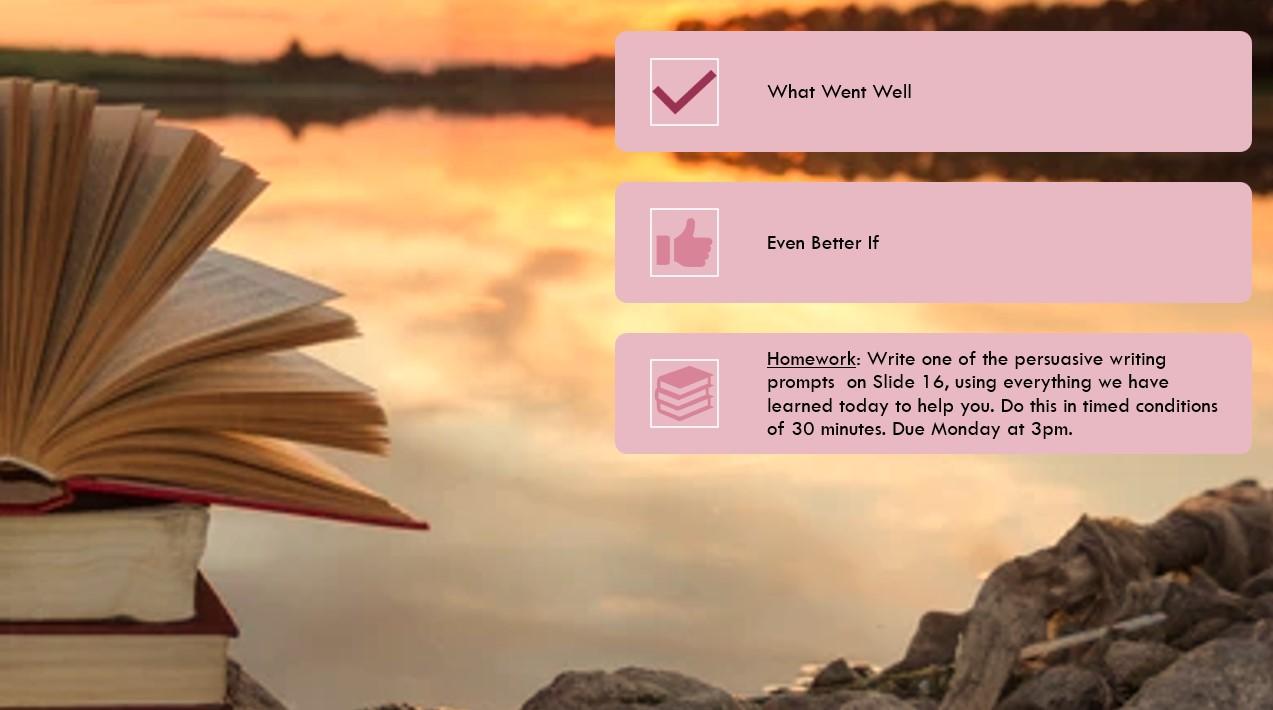› Forums › 2023 Easter › 2023 Easter
- This topic has 42 replies, 7 voices, and was last updated May 2, 2023 by
Beth.
-
AuthorPosts
-
-
at 11:40 #30677
Beth
ParticipantSummary for Lesson 1
In today’s lesson we began our work on 11+ comprehension and writing, beginning with comprehension in the first hour and switching to writing from a picture prompt in the second. In our comprehension class, we opened with an overview of four key skills (connotation, imagery, structure & theme), discussing what literary analysis required of us and how we can think about viewing literature through a lens. Then, we focused on the key skill of connotation analysis, digging into the way connotation and denotation differ and how this can be used symbolically, metaphorically, and to create negative/positive associations. We practiced writing utilising varied connotations and then analysed a passage from a text together, unpicking the hidden meaning behind the text. Finally, the class completed a P.E.E. paragraph on an 11+ comprehension passage, paying particular attention to the connotation of the words used. I was really impressed by the level of analysis the class exhibited today, particularly when it came to thinking about underlying imagery being used and how this could create a particular atmosphere i.e., the sinister, grotesque connotations and imagery in the Margaret Atwood passage contrasting the otherwise benign picture of a garden in bloom. Brilliant work on this today everyone- you should all be very proud of your ideas!
In our writing segment, we worked on writing from a picture prompt, beginning with an overview from an 11+ examiner video of what they are looking for in this exam and the key things to remember when writing the creative task. We then looked in depth at literary techniques, one of the most important parts of this exam, and the class discussed which they preferred to use and why. We applied this to a picture prompt, writing vivid, creative and unique literary techniques to fit within the story suggested by the image from an 11+ exam. Finally we discussed how to keep literary techniques (particularly simile and metaphor) fresh and exciting for the reader, completing a task on metaphorical association using the words “paper” and “child” to create interesting imagery. We also discussed in the lesson how to approach writing from a picture, using things such as theme, genre and observation to help create a framework from which to write. Excellent writing, concentration and contributions from everyone today, I really enjoyed hearing all the fantastic ideas you came up with and look forward to seeing you all tomorrow! Well done class 🙂
Connotation revision page with the videos I mentioned: https://www.studiobinder.com/blog/what-is-connotation-definition-examples/
The 11+ mock we used for the P.E.E. is attached below if you would like to have a look at it- you can post any questions on the forum 🙂
Writing video that we watched: https://www.youtube.com/watch?v=Jxo0BJXoFM8&t=137s
Homework

Attachments:
You must be logged in to view attached files. -
at 17:18 #30683
 Grace ZParticipant
Grace ZParticipantDear Beth,
Thank you for the lesson. I have learned a lot today.
I have attached my writing below.
Grace
Attachments:
You must be logged in to view attached files.-
at 19:41 #30771
-
-
at 11:24 #30692
Beth
ParticipantSummary for Lesson 2
In our lesson today we focused on poetry analysis and persuasive writing, thinking about how to draw on our ideas from the last lesson to apply to our topics today. In the poetry section of our lesson, we learned about what makes a poem a poem, digging into notions such as poetry being “literature with all the water squeezed out” and an art form where sound matters. We learned about the different terminology used when speaking about poetry (i.e., speaker, stanza, enjambment) and looked at how it is important to think about shape, imagery, sound, metaphor and rhythm. Finally the class applied this beautifully to an 11+ poem, analysing it in depth and thinking about the connotations, images and structure used by the poet. Finally we answered some 11+ comprehension questions on it (which the class did beautifully) and spoke about several different categories of imagery to look out for in a text: colour, nature, light, religious, violent and sensory. Incredible analysis today class, very impressive work 🙂
In the writing section we began work on persuasive writing, thinking about how to use various different forms of persuasion on a reader and how to work this into the exam context. We spoke about where to start with a persuasive writing prompt in an exam, thinking about three key pointers such as coming up with a thesis statement, not sitting on the fence unless specifically told to by the question, and using different types of evidence to back up your ideas. We watched a video that introduced Aristotle’s theory of rhetoric and spoke about the importance of logos, ethos and pathos in building a strong argument. We learned about the five-paragraph essay structure the class should endeavour to use, and the class then used this to write ‘speed thesis statements’ on a number of topics, eventually planning one of these in full with a range of evidence, from personal anecdote to statistic to expert opinion. The class wrote well-crafted and powerful responses to these prompts, thinking carefully about the range of ideas, points and arguments they could make in their persuasive essays. Really fantastic work everyone and brilliant engagement from all. Well done! 🙂
Video to watch for homework on poetry: https://www.youtube.com/watch?v=JwhouCNq-Fc
Video we watched in class on poetry: https://www.youtube.com/watch?v=zFNnbxCZPBU&t=23s
Video on persuasion that we watched: https://www.youtube.com/watch?v=O2dEuMFR8kw
Homework

Attachments:
You must be logged in to view attached files. -
at 10:51 #30698
Yihan
ParticipantHere is Yihan’s homework for the first session. He chose the picture of the bridge.
Attachments:
You must be logged in to view attached files.-
at 20:37 #30773
-
-
at 14:30 #30700
 Grace ZParticipant
Grace ZParticipantDear Beth,
Thank you for the lesson yesterday.
I wrote 32 minutes to add a bit about the other side of the argument. I picked to go against animal entertainment.
I have posted my homework below.
Grace
Attachments:
You must be logged in to view attached files.-
at 17:40 #30788
-
-
at 17:32 #30702
 KateParticipant
KateParticipantDear Beth,
Attached is my homework from Lesson 1. Thank you for a wonderful lesson!
Kate
Attachments:
You must be logged in to view attached files.-
at 20:56 #30775
-
-
at 20:46 #30705
MaxS
ParticipantDear Beth,
Thank you for your wonderful lesson, please have a look at my writing from the attached files.
Max
Attachments:
You must be logged in to view attached files.-
at 20:56 #30777
-
-
at 11:24 #30707
Lily Bloore
ParticipantHi Beth,
My homework for lesson 1 is attached below.
The format for the final paragraph went wrong and I couldn’t fix it, so please ignore it.
Thanks,
Lily
Attachments:
You must be logged in to view attached files.-
at 20:57 #30779
-
-
at 15:50 #30709
-
at 11:02 #30713
-
at 17:58 #30792
-
-
at 20:54 #30716
MaxS
ParticipantDear Beth,
Please have a look at my persuasive writing from the attached file. Thank you for your lesson.
Max
Attachments:
You must be logged in to view attached files.-
at 21:21 #30794
-
-
at 22:32 #30718
-
at 19:33 #30767
Lily Bloore
ParticipantHi Beth,
Here is my homework for lesson 2, thank you for the engaging lesson on Thursday.
Thank you,
Lily
Attachments:
You must be logged in to view attached files.-
at 21:33 #30796
-
-
at 11:19 #30783
Beth
ParticipantSummary for Lesson 3
In our lesson today we continued our work on 11+ analysis and writing, thinking about structure and continuing a story. We began with our comprehension lesson, learning about structure in writing and how this can be analysed alongside language in order to create compelling and nuanced points about a text. We learnt about different structural features such as pacing, openings, contrast, repetition and temporal references and thought about how we can think of structure in both macro and micro terms. We then watched a video specifying what structure is and how it works before looking at a GCSE list of different techniques and discussing how they work. The class then applied this to analysing an 11+ text which they did beautifully, questioning when and how the reader learns certain things and the impact of the way this is all put together. We dug into elements such as listing technique, punctuation, references to time and the fear of the unknown in this extract. Finally we looked at a model answer analysing the text’s structure and concluded the comprehension aspect of the lesson.
We moved on to talking about continuing the story- a common prompt in the creative writing section of the exam. We began by brainstorming some of the things that are easier and more difficult about writing from someone else’s story, thinking about characterisation, genre and perspective. We looked at some key tips and thought about how best to use aspects such as imagery and symbolism to create a sense of continuity between the original piece and the students’ continuation of the story. We discussed how to best approach these challenges before thinking about this in relation to an example. The class then completed some group work, coming up with their own continuations of the passage we had analysed in class, which they did fantastically well with, engaging with the task in a creative and inspired way. Finally we finished up by looking at an alternative kind of continue-the-story prompt which gives only a line to go off and discussed how to approach this, sharing our ideas. Great work today everyone, well done for all your contributions and ideas. See you tomorrow 🙂
Watch this video on structure to help you think more about it: https://www.youtube.com/watch?v=wp80ZUvnCiY
Imagery video to watch: https://www.youtube.com/watch?v=uX413tALG7Q
Symbolism video we watched in class: https://www.youtube.com/watch?v=GR9VbSXxouM
Homework

Attachments:
You must be logged in to view attached files. -
at 16:02 #30786
 Grace ZParticipant
Grace ZParticipantDear Beth,
Thanks for the lesson, I really enjoyed it.
I have attached my homework below.
Grace
Attachments:
You must be logged in to view attached files.-
at 14:31 #30824
-
-
at 11:28 #30802
Beth
ParticipantSummary for Lesson 4
In today’s class we completed our Easter course, thinking today about poetry and persuasive writing. We began with a poetic analysis, the class dissecting a poem for language and structure and then sharing ideas, which they did brilliantly! We thought about how poetry changes word order and plays with homonyms and homophones, digging into ways to ‘read for meaning’ in a poem, and thinking about using the title to help distinguish the moral. We then spoke about themes and how to extract what a poem is really about, before applying this to the poem Material by Ros Barber. We analysed the poem for theme, language, structure and imagery, learning what an extended metaphor is and thinking about how to apply this. Finally we had a quick Q&A on comprehension as a whole.
In the second half of the lesson we completed our persuasive writing work, learning about new persuasive techniques and thinking about how to apply them. The class analysed a persuasive speech from Braveheart, discussing how the author had used techniques such as personal pronouns, rhetorical questions, emotive language and direct address. The class wrote their own examples of persuasive techniques of their choice (amazing work on this class) before conducting a great flash debate on whether we should go looking for alien life in outer space. They wrote persuasive speeches on this in teams and then debated as a whole class, coming up with excellent and very compelling arguments for and against the proposition. Finally, we touched on essay structure one more time, using feedback from the homework to help us think about what to work on next. Incredible work as ever class- it’s been a joy teaching you all this Easter and I look forward to reading all your work! I hope to see you all again soon, really well done and have a lovely week 🙂
Video to watch for homework: https://www.youtube.com/watch?v=eREopphW5Bw
Theme page to look at for revision: https://www.bucks.edu/media/bcccmedialibrary/tutoring/documents/writingareahandoutrevision/literature/Identifying-themes.pdf
Homework

Attachments:
You must be logged in to view attached files. -
at 20:41 #30811
 Grace ZParticipant
Grace ZParticipantDear Beth,
Thanks for the lesson.
I have attached my homework below.
Grace
Attachments:
You must be logged in to view attached files.-
at 14:45 #30826
-
-
at 18:55 #30855
Lily Bloore
ParticipantHi Beth,
Here is my homework for lesson 3.
Thank you for the cool lesson.
Lily
( P.S. I will post my lesson 4 homework soon)
Attachments:
You must be logged in to view attached files. -
at 19:50 #30857
Lily Bloore
ParticipantHi Beth,
Here is my other homework (lesson 4).
Thank you for the amazing course.
Lily
Attachments:
You must be logged in to view attached files.-
at 14:05 #30991
-
-
at 20:59 #31022
-
-
AuthorPosts
- You must be logged in to reply to this topic.




